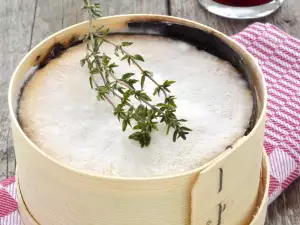Emmental, known as Emmentaler is a traditional Swiss cheese that is produced in the region of the river Emme, Canton Bern. It is from there that the cheese has received its name. Very unfortunately, the name Emmental is not reserved as a trademark and today it is produced more than one or two countries in the world.
The biggest producers and exporters of this cheese are France, Austria, Ireland, Denmark, Germany and Finland. However, this is not the case with the name Ementaler - it is a registered trademark and may only be used on cheese produced in Switzerland. Only since 2006 is Emmentaler a registered trademark in Switzerland.
Original Emmentaler has to mature for at least a period of four months. There is a circular and natural crust and traditional storage cellars are cool. It is believed that Emmental is one of the most difficult to produce cheeses, because there is a long fermentation process, during which it typically forms holes.

In essence, Emmental cheese is yellow, has a moderately firm texture and large round holes that make it very easy to recognize and remember. The reason for these holes is not an attempt to save material /as some jokers state/. As already mentioned the process of aging is complicated. During this period, it releases carbon dioxide from one of the three bacteria that are used to make it.
These bacteria are Lactobacillus, Propionibacter Shermani and Streptococcus Thermophilis. The first two are responsible for the release of carbon dioxide. The size of the holes range from cherry to walnut- like, they are not a clear criterion for the quality of the cheese. However, it is more likely for cheese with large and elongated holes to have a mild flavor, while small and round holes are indicative of spicy and strong taste.
In the period of aging, Swiss Emmental is divided into several types - "Classic" which ages four months, "Reserve" with a maturation period of eight months and "Premier Gru", a maturation period of 14 months. The last type Emmentaler won first place in the Cheese World Cup in the U.S. in 2006, where 1.700 cheeses from around the world were featured.
Emmental cheese is first mentioned back in 1293. A very interesting fact about the production is that to make a cake with an average weight of 70 kg, between 700 and 900 liters of milk are required - a really large amount, which determines the high price of this cheese.

Composition of Emmental
Emmental has a very diverse composition. It is rich in potassium and sodium, protein and fat, water, vitamins A, E, B6, B12 and C. It is composed of calcium and iron, phosphorus, magnesium, thiamine, beta carotene, choline, copper, selenium.
100 g of Emmental contains 380 calories, 27.8 g fat, 27 g protein, 5.4 g carbohydrates, 791 mg calcium, 15.5 mg choline, 567 mg phosphorus, 92 mg cholesterol, 0.2 mg iron.
Selection and storage of Emmental
Emmental cheese is found in large cakes, and in contrast, small packages too. When you buy Emmental note the information about the producer and natural durability. Store it in the refrigerator, well wrapped in packaging to prevent drying.

Emmental in cooking
Typical for each Emmental is the taste of nuts, which increases in the more mature cheeses. Young cheeses have a mild to sweet, nutty flavor, while the cheeses are mature in 4-5 months and have a strong, even pungent flavor.
You can eat Emmentaler in sandwiches and salads, or used for sprinkling different dishes. Emmental, with another very famous cheese – cheddar, is one of the two most commonly used cheeses in America to make hamburgers and sandwiches with. Melted Emmental is an important component of gratin and the infamous fondue.
Like most cheeses, Emental makes for a wonderful accompaniment to wine. If you combine it with red wine, opt for lighter fruit varieties, such as gametes or Pinot Noir. Among white wines, best suited are light and fresh wines - Pinot Blanc, or Traminer.




















Comments